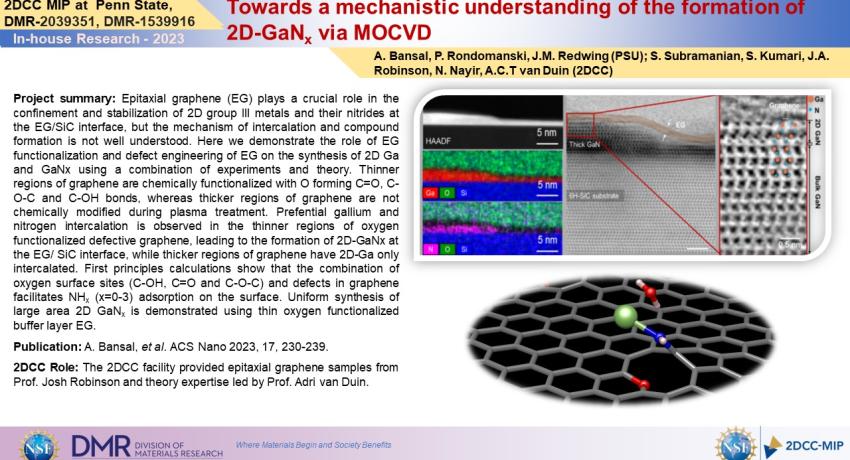Epitaxial graphene (EG) plays a crucial role in the confinement and stabilization of 2D group III metals and their nitrides at the EG/SiC interface, but the mechanism of intercalation and compound formation is not well understood. Here we demonstrate the role of EG functionalization and defect engineering of EG on the synthesis of 2D Ga and GaNx using a combination of experiments and theory. Thinner regions of graphene are chemically functionalized with O forming C=O, C-O-C and C-OH bonds, whereas thicker regions of graphene are not chemically modified during plasma treatment. Preferential gallium and nitrogen intercalation is observed in the thinner regions of oxygen functionalized defective graphene, leading to the formation of 2D-GaNx at the EG/SiC interface, while thicker regions of graphene have 2D-Ga only intercalated. First principles calculations show that the combination of oxygen surface sites (C-OH, C=O and C-O-C) and defects in graphene facilitates NHx (x=0-3) adsorption on the surface. Uniform synthesis of large area 2D GaNx is demonstrated using thin oxygen functionalized buffer layer EG.
2DCC Role: The 2DCC facility provided epitaxial graphene samples from Prof. Josh Robinson and theory expertise led by Prof. Adri van Duin.
What Has Been Achieved: We have demonstrated the important role of defects and chemical functionalization of graphene on the adsorption and intercalation of Ga and N into epitaxial graphene to form 2D GaNx. It was found that thin buffer layers of graphene become oxygen functionalized which enhances the adsorption and intercalation of N to form 2D GaNx. In thicker graphene regions that do not undergo functionalization, only 2D Ga is present.
Importance of Achievement: Defects and functional groups in epitaxial graphene play a key but poorly understood role in the intercalation of metals and chemical conversion to form 2D GaNx. Illuminating the complex interplay between defects/functional groups and EG provides clues into the atomistic mechanism of intercalation process that make it possible to control the growth conditions, and thus, to synthesize large area and uniform 2D-GaNx.
Unique Features of the MIP That Enabled Project: High quality epitaxial graphene samples synthesized in the 2DCC facility and theory expertise on DFT and ReaxFF.
Publication: A. Bansal, N. Nayir, K. Wang, P. Rondomanski, S. Subramanian, S. Kumari, J.A. Robinson, A.C.T. van Duin, J.M. Redwing, Toward a Mechanistic Understanding of the Formation of 2D-GaNx in Epitaxial Graphene, ACS Nano 17 (1), 230-239 (2023). https://doi.org/10.1021/acsnano.2c12345.
Acknowledgments: Financial support was provided by the National Science Foundation through DMR-1808900 and the 2D Crystal Consortium–Materials Innovation Platform (2DCC-MIP) at The Pennsylvania State University under NSF cooperative agreements DMR-1539916 and DMR-2039351. We thank H. Wang for TEM sample preparation using FIB. All microscopy work was performed at the Penn State Materials Characterization Laboratory.
